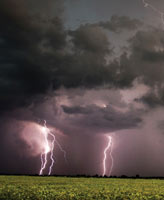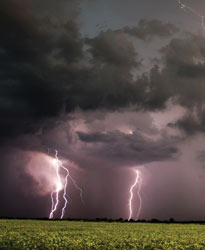
Dealing with Outdoor Hazards
Safe use of electricity is a big concern at home. And an average of 62 people are killed each year by lightning in the United States.
 THIS is part of my continuing series of useful links from the Internet. In this month’s edition, we look at Summer Safety. Underground Cables and Electricity In the summer, we may be doing some home remodeling to ensure that we have curb appeal. This means we have to dig up the ground around the home. Before we can do that, we have to get a utility markout by calling at least three days before we start work. The One-Call Systems (Dig- Safe) groups have launched one number for nationwide use. Call 8-1-1 at least three days before you dig. If you want local numbers for your state, go to www.digsafely.com/ contacts.htm.
THIS is part of my continuing series of useful links from the Internet. In this month’s edition, we look at Summer Safety. Underground Cables and Electricity In the summer, we may be doing some home remodeling to ensure that we have curb appeal. This means we have to dig up the ground around the home. Before we can do that, we have to get a utility markout by calling at least three days before we start work. The One-Call Systems (Dig- Safe) groups have launched one number for nationwide use. Call 8-1-1 at least three days before you dig. If you want local numbers for your state, go to www.digsafely.com/ contacts.htm.
To have fun in the sun sometimes requires that we have electricity available. To do that safely, we may need an extension cord, a ground-fault circuit interrupter (GFCI), and some equipment to plug into it. The Electrical Safety Foundation International (ESFi) has a library of information available for free, just by downloading it. Go to www.esfi.org/ esfi-library.html. More on electrical safety can be found at www.fire.nist.gov/ factsheets/Electrical.pdf, which is a tips sheet on Electrical Safety.
The Consumer Product Safety Commission has a short bulletin reminding you about GFCI usage and some nice clip art at www.cpsc.gov/cpscpub/pubs/5040.html.
Going camping? Or do you need electrical power after a hurricane? Use a portable generator and read OSHA’s Fact Sheet before you go: www.osha.gov/ OshDoc/data_Hurricane_Facts/portable_ generator_safety.pdf.
Sun and Water Safety
If you’re intent on sun tanning during the summer, the Food and Drug Administration has some safety tips about “The Darker Side of Tanning,” as does EPA. Go to www .fda.gov/cdrh/consumer/tanning.html and www.epa.gov/sunwise/actionsteps.html.
What is the summer without some swimming, skin diving, and boating? Who else can provide authoritative information but the leader in water safety, the Red Cross. Find its information at: (ARC) www.redcross.org/services/hss/tips/ healthtips/safetywater.html or (CRC) www.redcross.ca/article.asp?id=022569 &tid=001.
Rip Current Awareness Week has passed for this year (June 3-9, 2007). Still, rip currents are something very real that ocean and lake swimmers should be aware of. You can find more about these currents at www.ripcurrents.noaa.gov.
Safe Grilling
What would summertime fun be without a picnic? That means food safety. The CDC’s Grillin’ and Chillin’ food safety page can be found at www.cdc.gov/foodsafety/grill.htm, while the Wisconsin Department of Health offers some Summertime Food Safety Precautions that can be found at dhfs.wisconsin.gov/hometips/dhp/summerfoodsafety.htm.
Lightning
In the United States, an average of 62 people are killed each year by lightning. There were 47 confirmed deaths and 246 confirmed injuries in 2006. The injury number is likely far lower than it actually should be because many people do not seek help, or doctors do not record the visit as a lightning injury.
The National Weather Service is a great place to start with a lightning awareness page at www .lightningsafety.noaa.gov. At this site are handouts, some tips on indoor and outdoor awareness, and a new children’s page.
More is available for children at a FEMA Web page about lightning: www.fema.gov/kids/thwhat.htm. You and they can follow the links at the bottom of the page for more information about lightning.
Along with lightning comes—thunder, Thunder, THUNDER. The New York City Office of Emergency Management provides some tips on thunderstorms and lightning at http://nyc.gov/html/oem/ html/hazards/weather_thunder.shtml. (Links on this page lead to information about other hazards, including extreme heat, carbon monoxide, severe weather, fires, floods, and more.)
I remember back in elementary and high school going to the science museum and watching the indoor displays of lightning. The Tesla Coil develops static electricity that can cause your hair to stand on end or light a fluorescent light bulb.
This article originally appeared in the September 2007 issue of Occupational Health & Safety.